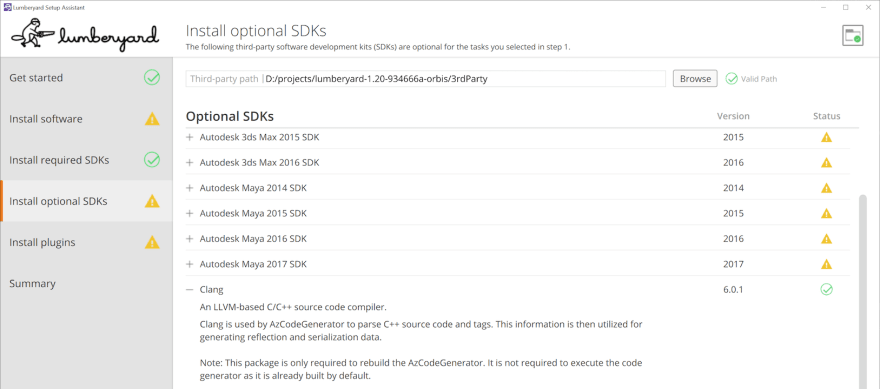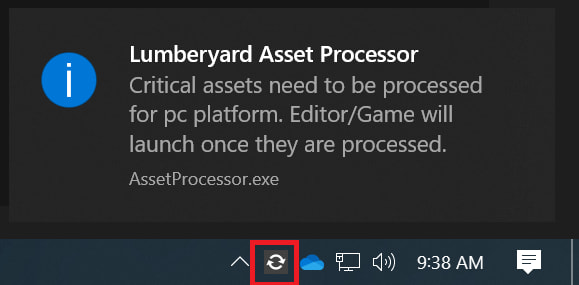Some years ago we worked with CryEngine, and more recently we’ve started working with its descendant- Amazon Lumberyard. Both game engines originated from the same codebase, but since Amazon acquired the source code in 2015 they have diverged significantly.
Here we’ll look at doing the basics- getting it building and running. If you’re of the creative/artistic persuasion and more interested in white-boxing levels or massaging materials, check out some of the many excellent resources on their respective dev portals, YouTube, etc.
Git Started
First, make sure you appease the Lumberyard hardware requirements:
3GHz minimum quad-core processor
8 GB RAM minimum
2 GB minimum DirectX 11 or later compatible video card
NVIDIA driver version 368.81 or AMD driver version 16.15.2211 graphics card
60 GB minimum of free disk space
To compile builds:
14 GB RAM minimum
Besides downloading the installer (which also includes the source code), you can pull it from github:
git clone https://github.com/aws/lumberyard
cd lumberyard
./git_bootstrap.exe
If git_bootstrap doesn’t work for some reason (it didn’t for me):
- Download the zip specified in
bootstrap_config.jsonby some other means - Unzip to the repository root
- Run
./SetupAssistant.bat
IMPORTANT : You need a lot of disk space. Around 30GB for source code, required SDKs, and the samples. Another 50GB to build one configuration of the game, editor, and tools.
Configuration
Lumberyard uses WAF for it’s build system via dev/lmbr_waf.bat.
The user guide contains a list of commands, but to get started you’ll need:
# Detailed commands and options
./lmbr_waf.bat --help
# Just list of commands
./lmbr_waf.bat --list
# GUI configuration
./lmbr_waf.bat show_option_dialog
show_option_dialog presents a bunch of different options, but perhaps the most important are Visual Studio Project Generator and Game Projects :
| VS Project Gen | Game Projects |
|---|---|
 |
 |
If you don’t want to futz with the janky Tkinter UI, you can also manually edit dev/_WAF_/user_settings.options and then run lmbr_waf configure.
Building
Waf commands follow the format of (build|clean|package|deploy)_platform[_arch]_toolchain_configuration. For example:
./lmbr_waf.bat build_win_x64_vs2017_profile
NB : If you don’t have Incredibuild you’re looking at hefty build time; 35 minutes on 12-core i9/64 GB/SSD.
“Specs” are pre-defined subsets of projects: “all” is everything, “game”, “tools”, etc. They are defined in dev/_WAF_/specs/ and appear in Visual Studio as Solution Configurations. You can build a spec from the command line:
./lmbr_waf.bat <command> -p <spec>
# Build engine and editor
./lmbr_waf.bat build_win_x64_vs2017_profile -p engine_and_editor
# Build game(s) and engine
./lmbr_waf.bat build_win_x64_vs2017_profile -p game_and_engine
Common Problems
If you’re using the latest version of Visual Studio 2017, waf may complain that it can’t find Visual Studio. In show_option_dialog, change Windows Options > win_vs2017_vswhere_args to:
-version [15.7.27703.2035,16]
Alternatively, in dev/_WAF_/usersettings.options:
# OLD
;win_vs2017_vswhere_args = -version [15.7.27703.2035,15.9.28307.665]
# NEW
win_vs2017_vswhere_args = -version [15.7.27703.2035,16]
IMPORTANT : Do not insert a space in the version array (i.e. [15.7.27703.2035, 16]). It will fail to find a Visual Studio install. Lines 795-796 in dev\Tools\build\waf-1.7.13\lmbrwaflib\mscv_helper.py are to blame.
If it fails with the innocuous looking unable to find QT:
[SETTINGS] msvs_version = 15 (default 14)
[SETTINGS] win_vs2017_vswhere_args = -version [15.7.27703.2035, 16] (default -version [15.7.27703.2035,15.9.28307.665]) [SETTINGS] specs_to_include_in_project_generation = all,game_and_engine,engine_and_editor,game (default all, game, game_and_engine)
[SETTINGS] Target Output folder (win_x64_vs2017/profile): Bin64vc141
[WARNING] Incredibuild disabled by build option
unable to find QT
unable to find QT
Traceback (most recent call last):
<SNIP>
File "Tools\build\waf-1.7.13\lmbrwaflib\cry_utils.py", line 872, in add_compiler_dependency
if os.path.isabs( self.env['CC'] ):
File "D:\projects\lumberyard\dev\Tools\Python\2.7.12\windows\lib\ntpath.py", line 59, in isabs
return s != '' and s[:1] in '/\\'
TypeError: 'in <string>' requires string as left operand, not list
It could be any of several issues:
- Missing one or more Visual Studio requirements
- MFC may also be required (forum post #1, #2)
- Problem detecting Visual Studio, check output of
lmbr_waf configurefor clues
If you get a bunch of the following errors, try re-running lmbr_waf configure:
ObjectStream.cpp
XXX\dev\Code\Framework\AzCore\AzCore/XML/rapidxml.h(20): fatal error C1083: Cannot open include file: 'rapidxml/rapidxml.h': No such file or directory
compression.cpp
XXX\dev\Code\Framework\AzCore\AzCore\Compression\compression.cpp(24): fatal error C1083: Cannot open include file: 'zlib.h': No such file or directory
ScriptContextDebug.cpp
XXX\dev\Code\Framework\AzCore\AzCore/Script/lua/lua.h(16): fatal error C1083: Cannot open include file: 'Lua/lua.h': No such file or directory
ScriptPropertyTable.cpp
XXX\dev\Code\Framework\AzCore\AzCore\Script\ScriptPropertyTable.cpp(20): fatal error C1083: Cannot open include file: 'Lua/lualib.h': No such file or directory
If you get an error like:
[2585/8092] pch_msvc (win_x64_vs2017|profile): Code\Tools\AzCodeGenerator\AZCodeGenerator\precompiled.cpp -> BinTemp\win_x64_vs2017_profile\Code\Tools\AzCodeGenerator\AZCodeGenerator\precompiled.4870660.obj BinTemp\win_x64_vs2017_profile\Code\Tools\AzCodeGenerator\AZCodeGenerator\precompiled.4870660.pch
precompiled.cpp
XXX\dev\code\tools\azcodegenerator\azcodegenerator\precompiled.h(31): fatal error C1083: Cannot open include file: 'clang/AST/Stmt.h': No such file or directory
It’s probably an issue with an optional SDK: 
Either install it, or build a different spec like -p engine_and_editor.
Running
If you build an editor spec you can run dev\Bin64vc141\Editor.exe to launch the level editor:

Depending on the game projects you enabled, if you build a game spec you can run one or more dev\Bin64vc141\<game>Launcher.exe.
The first time you launch either you should see a notification about the Asset Processor:

The asset processor is responsible for preparing assets for use by the engine runtime. This includes: processing FBX files, DXT/ETC texture compression, and more. We’ll look at this more when we investigate the asset pipeline and release packaging.
This is StarterGameLauncher.exe:

Don’t be surprised if it doesn’t immediately look like this. The sixth line of the debug text in the upper-right corner displays information about the “ShaderCache”. In this case:
- 22 “GCM” stands for Global Cache Misses (i.e. missing shaders)
- 6 outstanding Asynchronous Requests
- Compiling is enabled
Again, we’ll cover this when we look at the asset pipeline, but it is all about the Remote Shader Compiler which compiles shaders for the game client. If you wait a minute or two things will display correctly. If it’s not working, run .\Tools\CrySCompileServer\x64\profile\CrySCompileServer_vc141x64.exe (enabled with “all” spec).





Top comments (2)
I've been really meaning to install LumbYard. Thanks for the intro.
You're very welcome!